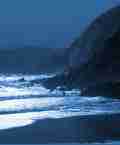 |
Search the site:

The Celtspart 2The Celts were not, of course, the first inhabitants of Ireland. At the end of the Ice Age, as the climate became warmer ñ say about 6,000 B.C. - early migrants probably crossed the narrow sea from Scotland to the Antrim coast and gradually moved further south. They lived a primitive existence by hunting in the forests and streams and lakes. Next came the first farmers who used stone implements for felling trees and preparing the soil for grain, kept large quantities of cattle, sheep and pigs, and raised huge stone monuments to their dead like the tombs in the Boyne Valley and on the Lough Crew hills. Perhaps by 2,000 B.C. a new group of settlers had arrived, metal-workers in search of gold and copper, who fashioned the artistic ornaments now in the National Museum in Dublin, the greatest collection of prehistoric gold objects in Western Europe. These were the dominant people in Ireland in the late Bronze Age when the Celts arrived. The Celts had the great advantage, for conquest, of having weapons made of iron. They seem to have moved into Ireland in two waves, one directly from the continent, perhaps from northern Spain or western France, into the west of the country and the other through Britain (which they had already conquered) into north-east Ireland. They may have begun to arrive as early as 500 B.C. and they were well established a century before Christ. To go further and try to estimate in what numbers or years the Celts arrived would be mere guesswork. With their arrival a new era had begun in Ireland. The Picts in the north and other pre-Celtic peoples were overthrown. No doubt they still formed a strong element in the population but they were assimilated in language and culture. With the Celts it was different. They dominated Ireland for nearly a thousand years and even when challenged by other cultures they were to resist and absorb them for many centuries more. Since writing arrived in Ireland only with the Roman alphabet, we know little about Celtic Ireland before the coming of Christianity. Roman writers called it both Scotia and Hibernia. But the epic tale of Táin Bó Cuailnge and other stories of the heroic age, written down centuries later, though not strictly history, are probably an accurate enough reflection of life in the immediate pre-Christian era.
Click here for part 3, or here for part 1.
From the Appletree Press title: The People of Ireland (currently out of print). |
All Material © 1999-2005 Irelandseye.com and contributors
